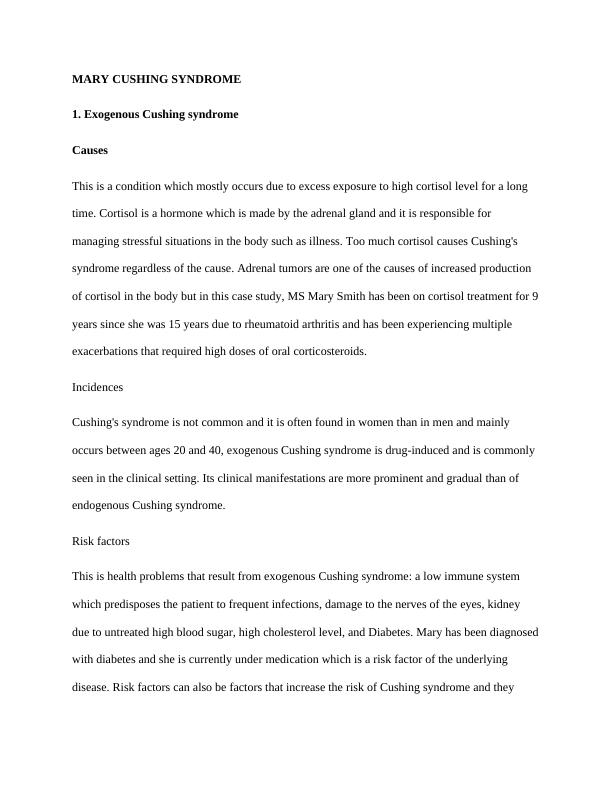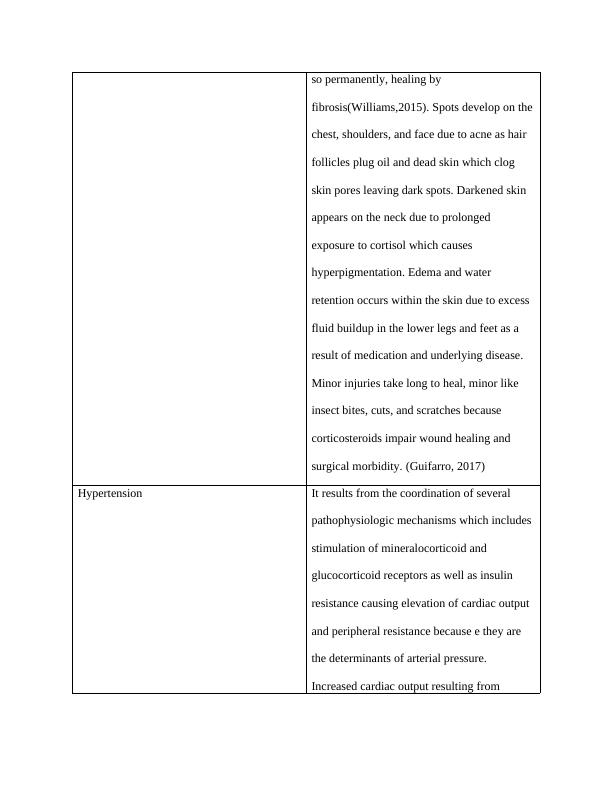Mary Cushing Syndrome: Causes, Incidences, Risk Factors, and Impact on Patient and Family
Added on 2023-04-21
11 Pages2099 Words68 Views
MARY CUSHING SYNDROME
1. Exogenous Cushing syndrome
Causes
This is a condition which mostly occurs due to excess exposure to high cortisol level for a long
time. Cortisol is a hormone which is made by the adrenal gland and it is responsible for
managing stressful situations in the body such as illness. Too much cortisol causes Cushing's
syndrome regardless of the cause. Adrenal tumors are one of the causes of increased production
of cortisol in the body but in this case study, MS Mary Smith has been on cortisol treatment for 9
years since she was 15 years due to rheumatoid arthritis and has been experiencing multiple
exacerbations that required high doses of oral corticosteroids.
Incidences
Cushing's syndrome is not common and it is often found in women than in men and mainly
occurs between ages 20 and 40, exogenous Cushing syndrome is drug-induced and is commonly
seen in the clinical setting. Its clinical manifestations are more prominent and gradual than of
endogenous Cushing syndrome.
Risk factors
This is health problems that result from exogenous Cushing syndrome: a low immune system
which predisposes the patient to frequent infections, damage to the nerves of the eyes, kidney
due to untreated high blood sugar, high cholesterol level, and Diabetes. Mary has been diagnosed
with diabetes and she is currently under medication which is a risk factor of the underlying
disease. Risk factors can also be factors that increase the risk of Cushing syndrome and they
1. Exogenous Cushing syndrome
Causes
This is a condition which mostly occurs due to excess exposure to high cortisol level for a long
time. Cortisol is a hormone which is made by the adrenal gland and it is responsible for
managing stressful situations in the body such as illness. Too much cortisol causes Cushing's
syndrome regardless of the cause. Adrenal tumors are one of the causes of increased production
of cortisol in the body but in this case study, MS Mary Smith has been on cortisol treatment for 9
years since she was 15 years due to rheumatoid arthritis and has been experiencing multiple
exacerbations that required high doses of oral corticosteroids.
Incidences
Cushing's syndrome is not common and it is often found in women than in men and mainly
occurs between ages 20 and 40, exogenous Cushing syndrome is drug-induced and is commonly
seen in the clinical setting. Its clinical manifestations are more prominent and gradual than of
endogenous Cushing syndrome.
Risk factors
This is health problems that result from exogenous Cushing syndrome: a low immune system
which predisposes the patient to frequent infections, damage to the nerves of the eyes, kidney
due to untreated high blood sugar, high cholesterol level, and Diabetes. Mary has been diagnosed
with diabetes and she is currently under medication which is a risk factor of the underlying
disease. Risk factors can also be factors that increase the risk of Cushing syndrome and they

include type 2 diabetes, poorly controlled blood sugar levels which still cause retinopathy and
nephropathy and high blood pressure resulting from the glucocorticoids or adrenocorticotrophic
hormone administration.
Impact of the disease to patient and family
Majority of patients said about how Cushing syndrome has affected their everyday life and effect
on their families at work and both at school. Quality of life is increasingly impaired in patients
with this disease regardless of treatment strategies and patients with Cushing syndrome report
more negative perception than those other patients with acute and chronic illnesses. Patient
experienced mental problems such as depression, anxiety, anger, and hostility mostly due to the
disease process and hospitalization, these conditions affect patient's concentration and even
memory. Patients with this disease also experienced low self-esteem due to impaired body shape
especially deposits of fat in the abdomen and round face. Patients experience pain. Patients with
this condition also experience complications for example kidney failure due to damage to its
nerves. This disease imposes a burden to the family caregivers and even others. Families
experienced psychological and non-health effects. They include changes in their daily activities,
some even didn't go for work to take care of the patient. Families had to even sell some of their
properties or raise money for payment of bills of a loved one who is sick.
2. Signs and symptoms
Signs and symptoms Pathophysiology
Weight gain Weight gain often occurs at the trunk and not
accompanied by weight gain in the arms and
the legs. High level of cortisol in the body
nephropathy and high blood pressure resulting from the glucocorticoids or adrenocorticotrophic
hormone administration.
Impact of the disease to patient and family
Majority of patients said about how Cushing syndrome has affected their everyday life and effect
on their families at work and both at school. Quality of life is increasingly impaired in patients
with this disease regardless of treatment strategies and patients with Cushing syndrome report
more negative perception than those other patients with acute and chronic illnesses. Patient
experienced mental problems such as depression, anxiety, anger, and hostility mostly due to the
disease process and hospitalization, these conditions affect patient's concentration and even
memory. Patients with this disease also experienced low self-esteem due to impaired body shape
especially deposits of fat in the abdomen and round face. Patients experience pain. Patients with
this condition also experience complications for example kidney failure due to damage to its
nerves. This disease imposes a burden to the family caregivers and even others. Families
experienced psychological and non-health effects. They include changes in their daily activities,
some even didn't go for work to take care of the patient. Families had to even sell some of their
properties or raise money for payment of bills of a loved one who is sick.
2. Signs and symptoms
Signs and symptoms Pathophysiology
Weight gain Weight gain often occurs at the trunk and not
accompanied by weight gain in the arms and
the legs. High level of cortisol in the body

leads to redistribution of fats to the chest and
stomach area. This goes hand in hand with
rounding of the face, becomes puffy and red.
A "buffalo hump" develops due to the
accumulation of fats in the shoulders and the
neck. Because cortisol level will be more than
normal it will require more carbohydrate. So
cortisol metabolizes the food and refuels the
body even when there is no requirement
within the body thus leading to weight gain.
(Wilson, 2017)
Skin changes The skin thins because cortisol causes
breakdown of dermal proteins responsible for
hardening and thickening of the skin, it also
weakens blood vessels.it weakens the skin
such that it becomes shiny, a paper-thin
quality which allows it to be torn so easily
thus it bruises easily. Reddish-purplish stretch
marks called striae appear commonly on the
stomach, thighs, arms limbs, breast and
buttocks, this is because Cushing syndrome
stretches the skin which is already thin due to
cortisol causing it to hemorrhage and stretch
stomach area. This goes hand in hand with
rounding of the face, becomes puffy and red.
A "buffalo hump" develops due to the
accumulation of fats in the shoulders and the
neck. Because cortisol level will be more than
normal it will require more carbohydrate. So
cortisol metabolizes the food and refuels the
body even when there is no requirement
within the body thus leading to weight gain.
(Wilson, 2017)
Skin changes The skin thins because cortisol causes
breakdown of dermal proteins responsible for
hardening and thickening of the skin, it also
weakens blood vessels.it weakens the skin
such that it becomes shiny, a paper-thin
quality which allows it to be torn so easily
thus it bruises easily. Reddish-purplish stretch
marks called striae appear commonly on the
stomach, thighs, arms limbs, breast and
buttocks, this is because Cushing syndrome
stretches the skin which is already thin due to
cortisol causing it to hemorrhage and stretch

so permanently, healing by
fibrosis(Williams,2015). Spots develop on the
chest, shoulders, and face due to acne as hair
follicles plug oil and dead skin which clog
skin pores leaving dark spots. Darkened skin
appears on the neck due to prolonged
exposure to cortisol which causes
hyperpigmentation. Edema and water
retention occurs within the skin due to excess
fluid buildup in the lower legs and feet as a
result of medication and underlying disease.
Minor injuries take long to heal, minor like
insect bites, cuts, and scratches because
corticosteroids impair wound healing and
surgical morbidity. (Guifarro, 2017)
Hypertension It results from the coordination of several
pathophysiologic mechanisms which includes
stimulation of mineralocorticoid and
glucocorticoid receptors as well as insulin
resistance causing elevation of cardiac output
and peripheral resistance because e they are
the determinants of arterial pressure.
Increased cardiac output resulting from
fibrosis(Williams,2015). Spots develop on the
chest, shoulders, and face due to acne as hair
follicles plug oil and dead skin which clog
skin pores leaving dark spots. Darkened skin
appears on the neck due to prolonged
exposure to cortisol which causes
hyperpigmentation. Edema and water
retention occurs within the skin due to excess
fluid buildup in the lower legs and feet as a
result of medication and underlying disease.
Minor injuries take long to heal, minor like
insect bites, cuts, and scratches because
corticosteroids impair wound healing and
surgical morbidity. (Guifarro, 2017)
Hypertension It results from the coordination of several
pathophysiologic mechanisms which includes
stimulation of mineralocorticoid and
glucocorticoid receptors as well as insulin
resistance causing elevation of cardiac output
and peripheral resistance because e they are
the determinants of arterial pressure.
Increased cardiac output resulting from

End of preview
Want to access all the pages? Upload your documents or become a member.
Related Documents
Bachelor Nursing Assignmentlg...
|12
|1934
|92
Cushing's Syndrome: Causes, Symptoms, and Treatmentlg...
|10
|1939
|333
NRSG353 Assessment Task 1 – Case Studylg...
|15
|3448
|252
A Case Report of Cushing's Syndromelg...
|9
|2494
|276
Nursing Case Study on Exogenous Cushing’s Syndromelg...
|10
|2522
|429
Nursing Assignment: Disease Impression, Causes, and Impact on Patient and Familylg...
|11
|2028
|374
